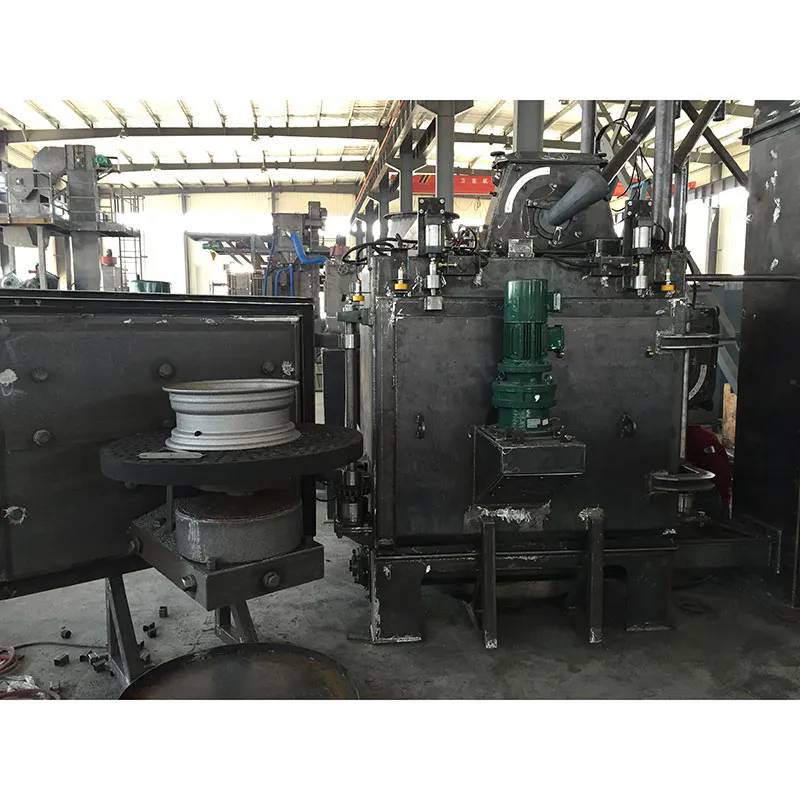Detailed Overview of Double Positions Rotating Table Type Shot Blast Machine
2024-07-30
A double positions rotating table type shot blast machine is an industrial machine designed for cleaning, preparing, or finishing the surfaces of metal parts through the use of abrasive media (such as steel shot or grit). It is commonly used in manufacturing and metalworking industries for processes like rust removal, deburring, and surface hardening. Here’s a detailed overview of its characteristics and features:
1. Design and Construction
- Rotating Table: Features a rotating table that holds the workpieces. This table can have two positions or workstations, allowing for simultaneous loading and unloading while the other station is in use for blasting.
- Double Positions: The machine typically has two distinct work positions or tables that rotate independently or simultaneously. This setup allows for efficient and continuous operation, minimizing downtime between cycles.
- Abrasive Delivery System: Includes an abrasive delivery system that propels abrasive media onto the workpieces. This system often includes a blast wheel or turbine to accelerate the media.
- Cabinet or Enclosure: The blasting area is enclosed to contain the abrasive media and control dust. The cabinet may include viewing windows or doors for operator access.
2. Operation and Functionality
- Rotating Mechanism: The rotating table or turntable rotates the workpieces to ensure uniform coverage of the abrasive media. This rotation helps achieve consistent cleaning or finishing.
- Blast Cycle: Workpieces are placed on the table, and the machine’s blast wheel or nozzle delivers abrasive media onto the surface. The rotation of the table ensures that all surfaces of the workpieces are treated.
- Dual Operation: With double positions, while one table is actively blasting, the other can be loaded or unloaded, allowing for a continuous workflow and reducing overall processing time.
3. Features
- Adjustable Blast Settings: The machine often has adjustable blast settings, including the speed and intensity of the abrasive media, to accommodate different types of workpieces and desired finishes.
- Media Recovery System: Equipped with a system to recover and recycle the abrasive media, which reduces waste and lowers operating costs.
- Dust Collection: Includes a dust collection system to remove and filter out airborne dust created during the blasting process, ensuring a cleaner and safer working environment.
- Control Panel: Features a control panel for operating and adjusting the machine’s settings, including blast time, rotation speed, and other parameters.
4. Applications
- Surface Cleaning: Used to clean metal parts by removing rust, scale, and other contaminants from the surface.
- Deburring: Effective for removing burrs and sharp edges from machined or cast parts.
- Surface Preparation: Prepares surfaces for further treatment, such as coating or painting, by creating a rough surface profile.
- Finishing: Provides a smooth, polished finish to metal parts, enhancing their appearance and performance.
5. Advantages
- Efficiency: The dual-position design allows for continuous operation and reduces downtime between processing cycles.
- Uniform Coverage: Rotating the table ensures that all surfaces of the workpieces are evenly treated, resulting in consistent cleaning or finishing.
- Reduced Labor: The machine automates the blasting process, reducing manual labor and improving productivity.
- Cost-Effective: The media recovery system minimizes waste and reduces operational costs over time.
6. Maintenance
- Regular Inspection: Routine inspection of components such as the rotating table, blast wheels, and media recovery system is necessary to ensure proper operation.
- Media Replacement: The abrasive media will wear out over time and need to be replenished or replaced.
- Cleaning: Regular cleaning of the dust collection system and machine components helps maintain performance and extend the machine’s lifespan.
7. Safety Considerations
- Protective Gear: Operators should wear appropriate personal protective equipment (PPE), such as safety goggles, gloves, and ear protection.
- Dust Control: Ensure the dust collection system is functioning correctly to minimize airborne dust and maintain a safe working environment.
- Training: Operators should be trained in the safe operation of the machine and emergency procedures.
Summary
The double positions rotating table type shot blast machine is a versatile and efficient piece of equipment used for cleaning, preparing, and finishing metal parts. Its dual-position design allows for continuous operation, improving productivity and reducing downtime. The machine features a rotating table, adjustable blast settings, and a media recovery system, making it suitable for a variety of applications such as rust removal, deburring, and surface preparation. Regular maintenance and safety precautions are essential to ensure optimal performance and operator safety.



